Neighborhood Brewers
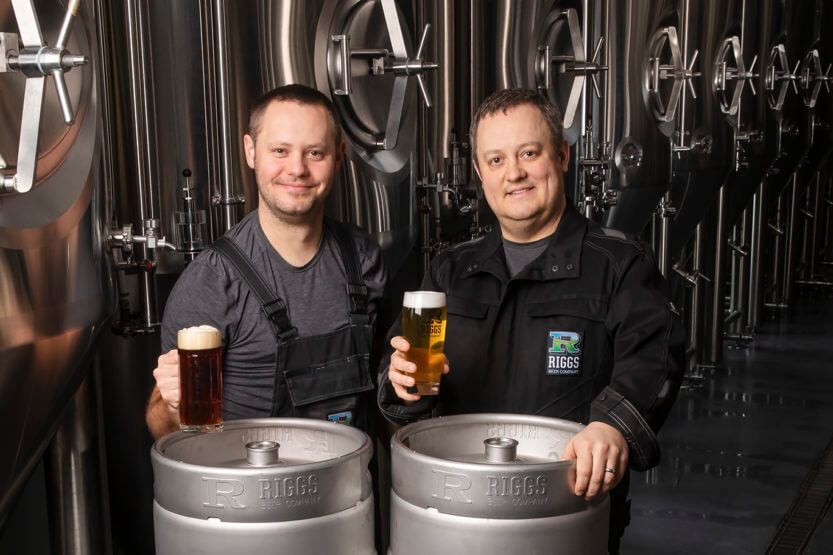 Matt (left) and Darin Riggs launched the Riggs Beer Company in May 2015, inspired by craft-brewed beers. Matt earned a German brewmaster certification from Doemens Akademie in Munich, while Darin completed the Master Brewers Program at the University of California, Davis. (Image by L. Brian Stauffer)
Matt (left) and Darin Riggs launched the Riggs Beer Company in May 2015, inspired by craft-brewed beers. Matt earned a German brewmaster certification from Doemens Akademie in Munich, while Darin completed the Master Brewers Program at the University of California, Davis. (Image by L. Brian Stauffer) San Diego was the port of call and discharge papers were the order of business when Darin Riggs, ’03 ENG, put ashore in December 2012, closing out his time cruising under the ocean in nuclear submarines, making sure their reactors behaved themselves. A Naval officer with an ROTC commission earned through the University of Illinois, Riggs walked off the boat and into civilian life knowing exactly what he wanted to do next: Make beer with his brother, Matt, ’06 ACES.
A few years before, when both brothers were stationed there—Matt as a UI ROTC-commissioned officer in the Marine Corps—San Diego was riding the tide of winning, fizzy, craft-brewed fermentations that would soon have the country awash in India pale ale and chocolate stouts. Between duty stations that included sailing around the world with a Marine expeditionary unit and running practice invasions, Matt had spent much of his free time ashore at San Marcos Brewery & Grill, working in return for food and beer. “To smell that mash for the first time on a brew day—it was like a hook,” he says. “I became convinced that this was what I wanted to do.”
By the time Darin disembarked from his sub for the last time, Matt had already resigned his commission and was working at a different brewery—in Germany. As for Darin, he was preparing to enroll in the Master Brewers Program at the University of California, Davis.
“We had had this pie-in-the-sky dream for a long time—from when we were undergraduates and we first tasted beer,” Matt recalls. “We said, ‘They make this from grain? We do grain back home on our farm. Why don’t we make this someday?’”
The Riggs brothers had seen the future. And it was a brewery.
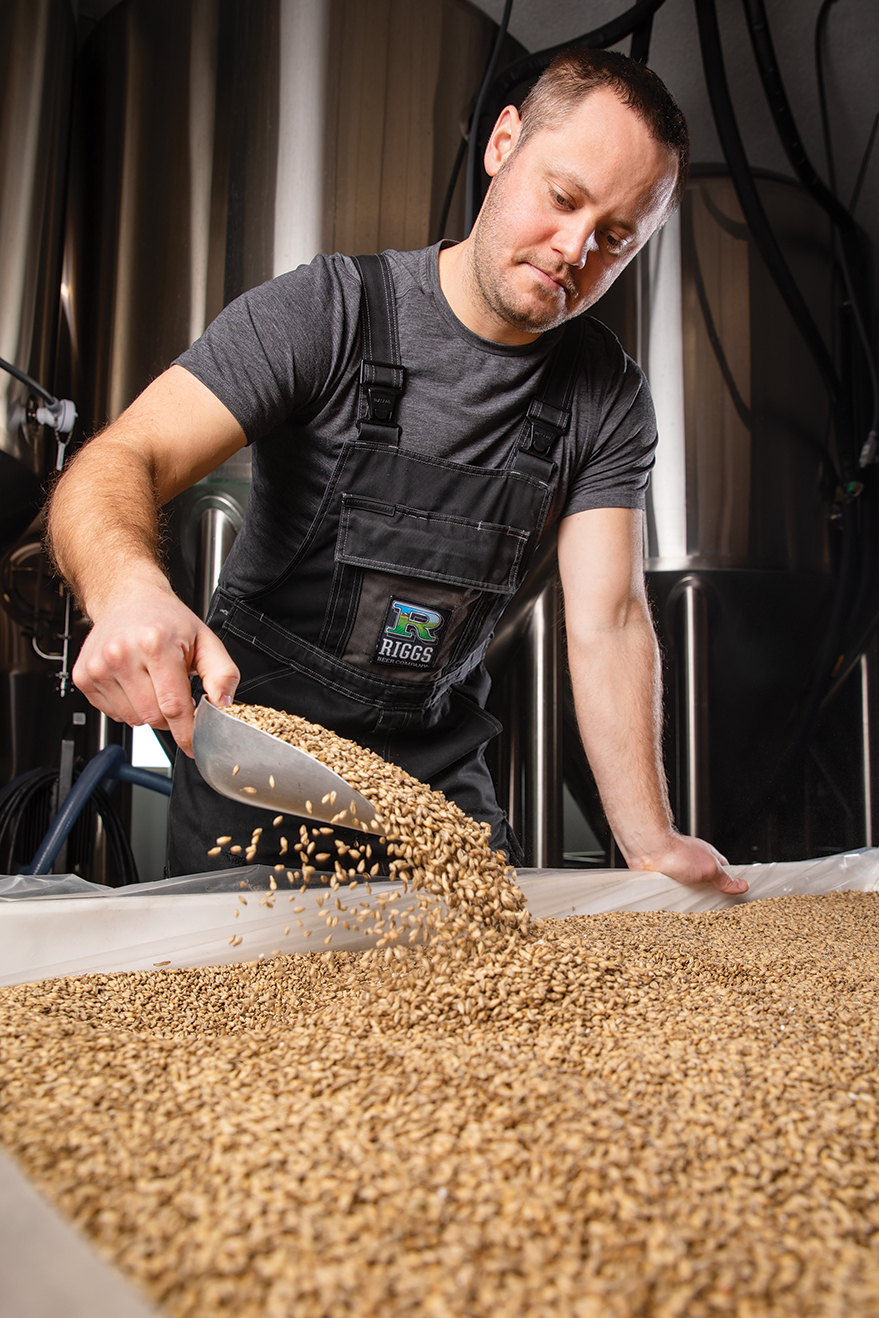
Matt inspects a container of Riggs-grown malted barley before sending it to the mill room. (Image by L. Brian Stauffer)
Something for every palate
Riggs Beer Company lies on the eastern edge of Urbana, just down the road from the farm where Darin and Matt were raised. The brewery has been up and running since May 2015; the taproom opened about a year later after navigating the requisite state-licensing perplexities. Sit down at the bar to sample Riggs beers, and you will be rewarded with brews that range from pale gold and delicate to red-hued and full-bodied. These beverages keep the taproom bubbling with thirsty locals and beer connoisseurs who stop in to comparison-check taste sensations with those gleaned in craft-brew capitals such as Seattle, Portland, Ore., and Asheville, N.C. Hefeweizen, a traditional German wheat beer, is the most popular product at the Riggs brewery, where the menu also features Red Lager, a dark malt described as a “German-American dual citizen,” and American and India Pale Lagers, both from mash that includes corn. Seasonal releases run the gamut from bocks and pilsners to an Oktoberfest and a Black IPL, and include Helles, a fruity German-style barley beer traditionally beloved for its exotic overtones of banana. Much of the grain that goes into these beers comes from the Riggs farm, where Darin now lives with his wife, Gail, and their daughters, Anna and Lilly. They are the fifth generation of their family to work the land.
The Riggs American Lager is a beer with global attitude and historic roots. “Only a handful of small breweries” make beer with corn in the mash, says Darin, who notes that this style of beer is singularly German-American, dating back to the days when immigrants settling in the Midwest made beer from the crops they could grow. Barley was—and always will be—essential to beer. Wheat plays well with barley. But back in settler days, corn was there, and corn went into the mash.
Since the Riggs brewing operation began two-and-a-half years ago, the brothers have fermented about 25 tons of grain harvested from their family’s farm, mostly corn and wheat. (The weather in central Illinois is a bit hot for barley, which is subject to fungus; the brothers grow it in limited quantities.) The rest of the grain and the all-important hops come from the closest local sources available, and malting takes place nearby. The Riggs motto is “On our farm, we grow beer.” Matt and Darin do so as organically as possible, with grains including Erisman soft red winter wheat and Illinois Low Oil corn, both developed at Illinois. (See sidebar pg. 26.) They are growing their business organically, too.
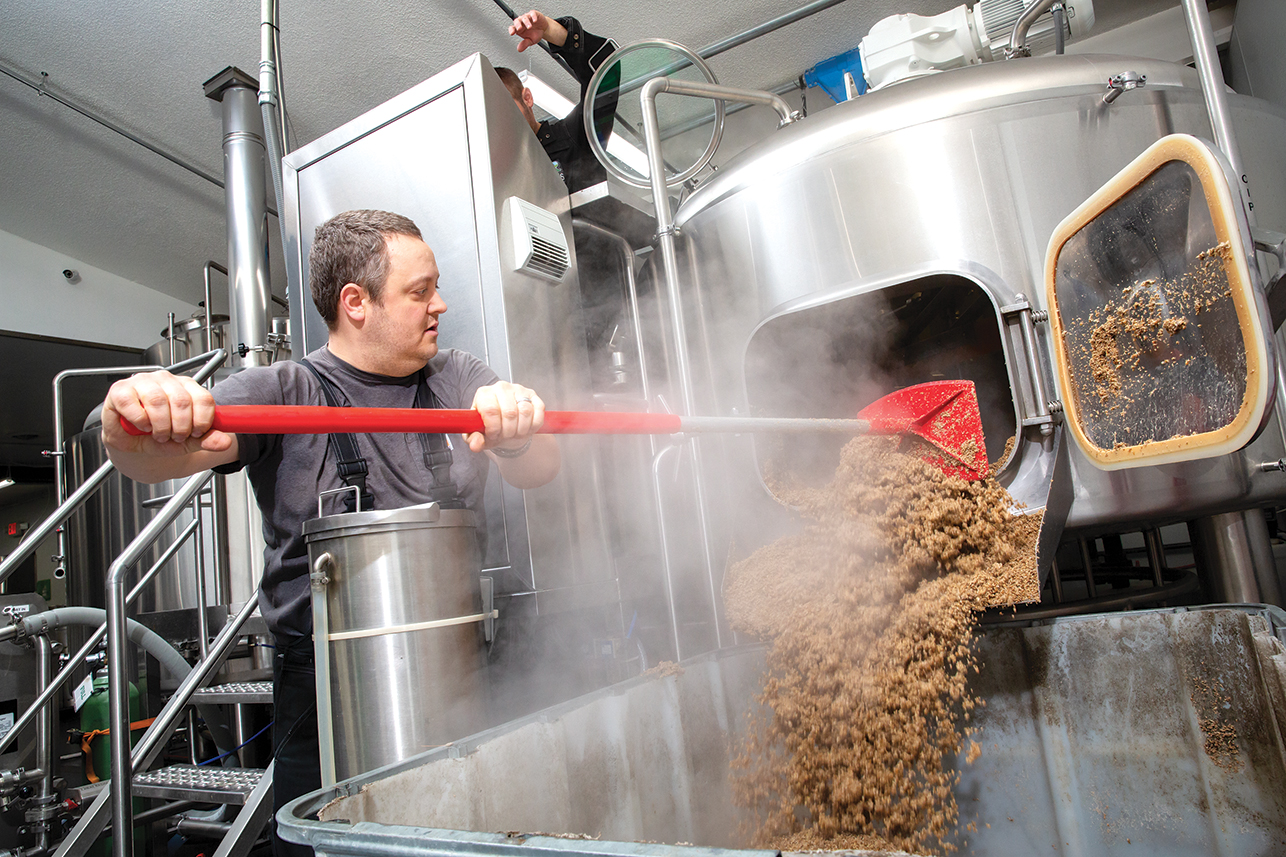
Darin removes spent grain from the brewhouse. A local livestock farmer will pick up the grain and use
it for feed. (Image by L. Brian Stauffer)
Thirty-five years ago, there were 50 microbreweries in the U.S. Now, some 7,000 compete for the 1 percent of beer-drinking consumers who prefer craft brews. It’s a slow-moving tsunami for which the Riggs brothers have designed their own special raft. They sell beer by the keg only (not to overlook taps and tap-filled growlers, of course) with distribution limited to approximately 350 bars and restaurants in central Illinois. When promoting Riggs beer to area bars and restaurants, Darin says, “I can go in and say, ‘Hey, listen—all these brands you have on tap I can get at the grocery store a block away for a third of the price. But a Riggs beer can only be had on tap.’” Wholesale represents 70 percent of their business.
“We designed this place from the ground up to be competitive at a relatively small level of production,” Darin says. The brothers are now selling a frothy half-million servings annually—a level that Matt notes, “may be our sweet spot.”
Certified brewmasters
Darin and Matt Riggs trace their fondness for beer back to their student days at Illinois, where they enrolled after graduating from tiny Heritage High School in Broadlands, Ill. (Matt was one in a class of 35, while Darin’s cohort had 38.) ROTC helped them meet the costs of their UI education, which for Darin meant majoring in computer science, and for Matt, studying technical systems management in the College of ACES. Even the formidable demands of military training and challenging studies did not preclude downing a few with peers when the opportunity presented itself.
“Darin and I were both on the Naval ROTC sailing team. We’d go up to Madison, Wis., and out to Boulder and the University of Colorado,” Matt recalls. “We would compete against their ROTC teams in sailing. Afterwards we’d all go out. This was the early 2000s, and there were breweries in Madison and Boulder. And we were, like, ‘How cool is this? They make beer here. We don’t have anything like that in central Illinois’.”
“We thought a local brewery was Leinenkugel’s, up in Chippewa Falls, Wis., because it wasn’t one of the big companies,” Darin adds. “We knew there was nothing like that here. And we saw that maybe someday that could be a great opportunity.”
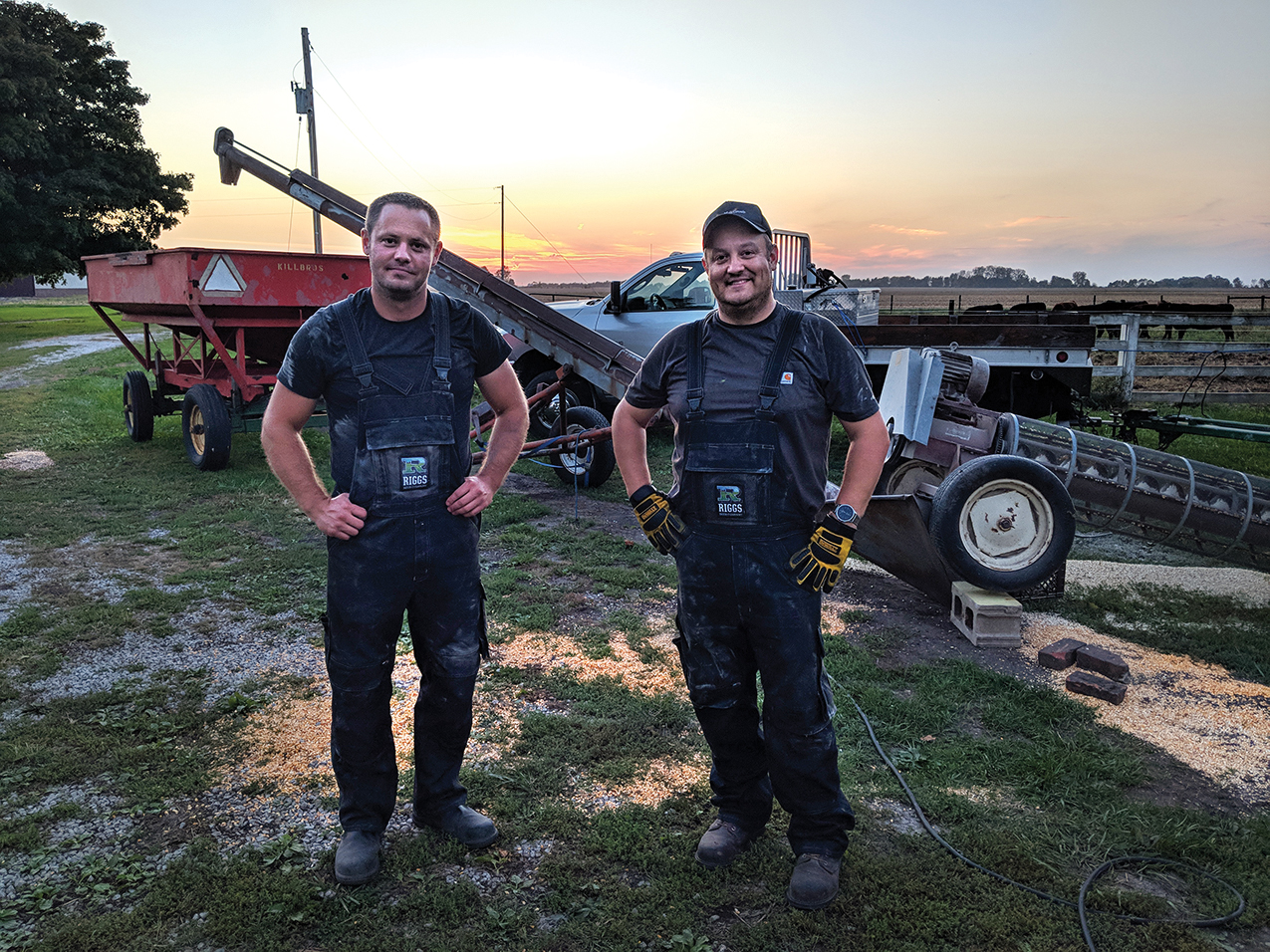
Matt and Darin cleaning corn on their farmstead, which has been continuously farmed since 1874. The brothers have fermented about 25 tons of grain harvested from the farm. (Image courtesy of Riggs Beer Company)
Matt went on to serve five years in the U.S. Marine Corps. Darin put in 10 years and remains a member of the U.S. Navy Reserve. After completing the 18-week brewery program at UC Davis, Darin moved down the road to a mega-brewery gig at the Anheuser-Busch plant in Fairfield, Calif. His background proved unexpectedly germane at the massive facility, where output was some 124 million gallons of beer annually. “I started out in a shift manager position,” Darin recalls. “And then, lo and behold, I started working with some of the automation equipment like the programmable logic controller—the things that keep the entire factory of conveyors and pumps and motors and everything operating. After about six months, I moved up to a process engineer position where I finally put my computer science degree to work.”
Matt, meanwhile, had winged off to Germany—homeland of his wife, Caroline, and of arguably the best beer in our part of the solar system. He secured an apprenticeship with Brauhaus Faust, a 362-year-old brewery in Bavaria, a region where wheat beer reigns—especially Hefeweizen. (Under Matt’s stewardship, the Riggs Hefeweizen has become the brothers’ most popular brew.) “Learning German at 28 is not the easiest thing in the world,” Matt observes. “But after about two days, my co-workers totally brought me into the fold. They realized, ‘Hey, this guy can hardly speak our language, but he’s hard-working and he wants to be here.’ I’ll never forget that.” From Faust, it was on to Doemens Akademie in Munich, where he earned German brewmaster certification.
By 2015, Darin and Matt Riggs were ready to bet the farm. “We literally put everything we had into this,” Matt says. They bought a derelict sports bar on the outskirts of Urbana—purchased, as it happened, from a neighbor whose farm adjoined their parents’ land. They procured top-of-the-line equipment, including 30 stainless-steel fermentation tanks in single, double and triple sizes, and a reverse-osmosis system to purify water for brewing. A four-vessel brewhouse allows rigorous control of the mash, the mix of malted grain and hops in which starch is converted to sugar, permitting subsequent fermentation of the beer. “IPAs, stouts and other craft beers don’t need a complex brewhouse,” says Matt. “German beers do.
“It’s like the difference between a $40 tool kit from Harbor Freight and a $5,000 Snap-on tool box,” he continues. “Sure, you can get some things done with one. But you can get a whole lot more done with the other.”
Their commitment to sustainability extends from using non-GMO grains and minimal fertilizer for the crops that go into their beer to restricted use of carbon dioxide and chemical cleaning compounds. It’s also reflected in the massive solar array on the edge of the brewery parking lot which, Matt jokes, “serves in place of a billboard” for their goal to produce at least 90 percent of their electricity needs from the sun.
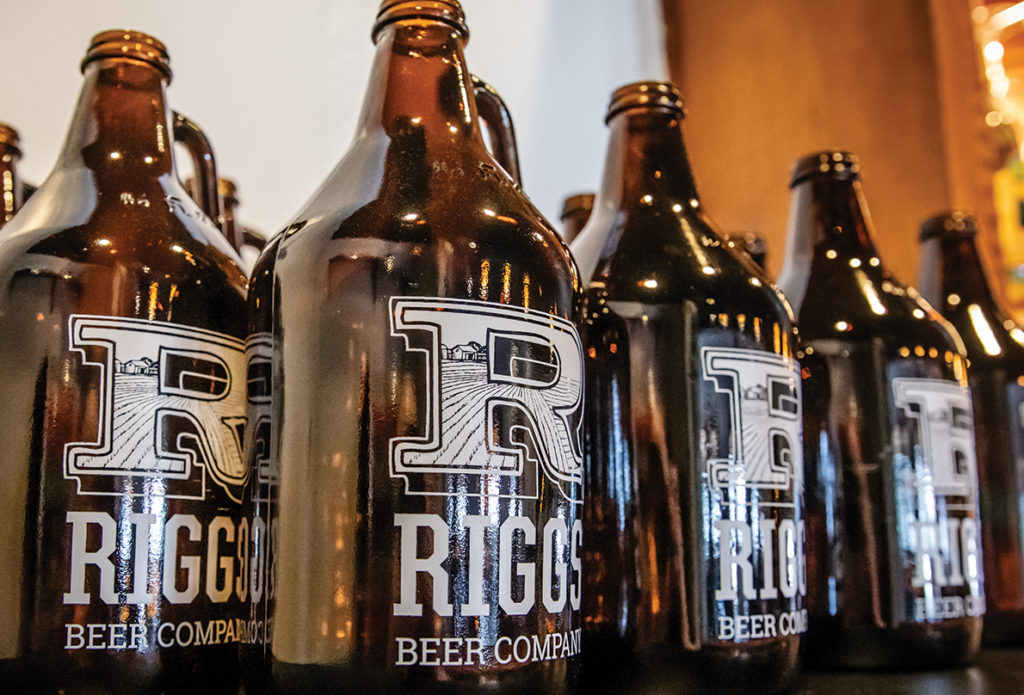
Riggs Beer is sold principally by the keg and distribution is limited to 350 bars and restaurants in central Illinois. Guests at the brewery’s taproom may also opt to take beer home in oversized glass vessels known as growlers. (Image by L. Brian Stauffer)
Navy-caliber discipline
Life at Riggs Beer Company appears to be a sort of mash itself: demand, labor, order, networking and whimsy all at once. Black staff uniforms—bill caps and jackets with the company logo, an “R” that encloses a stylized image of a farm field—hearken back to the operation’s military pre-history. Navy-caliber discipline is overt in top-to-bottom tidiness: The brewery is immaculate, having taken a year to emerge from the wreckage of the old sports bar. Three opportunistic cats wander the grounds.
On weekends, a loyal crowd flows in to occupy the easy-going taproom, with its central bar, big-planked tables and low benches. There are $10 tasting tours of the brewery on most Saturday and Sunday afternoons. Hipsters may come wheeling in via the nearby bike path. Retired military officers hoist glasses of Hefeweizen and Helles. “We have a pretty healthy clientele,” observes Darin. “People don’t come here to be overserved.” Brewery events range from receptions, weddings and private gatherings to live music, beer-release parties, board-game nights, drone races and Science on Tap, a monthly get-together featuring presentations by UI graduate students. Last spring, Illinois Alumni Association clubs leaders convened at Riggs Beer Company to kick off a three-day campus conference. Summers find the outdoor patio full of families, whose children climb on a tractor-shaped wooden gym built by Amish craftsmen. Because the sports bar’s commercial kitchen was swept away in the renovation blitzkrieg, food trucks hover in the front parking lot, offering cheesesteaks, nachos and jambalaya. A seating area off the taproom has big glass windows that roll up in season and offer a view of flat fields and soft horizons. This year, the brothers outlined the brewery’s rear boundaries with a cover crop of winter wheat, destined for their beer.
“There’s always a place for smaller-scale, locally owned and operated direct integration of food into the market. And we didn’t have that around here for a long, long time,” Matt says. “Bringing that back is a lot of fun. And this community has showed that they value that since the day we opened.”
Life on the farm may not get any better than this.
The Perfect Corn
Seeking special grain for special beers, Matt Riggs found the answer at Illinois

Darin watches the last of the 2018 brewing corn crop enter the grain cleaner. (Image courtesy of Riggs Beer Company)
Matt Riggs likes nachos as well as any modern adult with a penchant for taprooms. But not in his beer glass, please. That’s what he tasted when he and his brother, Darin, began tapping kegs of beer made with corn and wheat from their Illinois family farm.
“Oil in the germ of the corn can give a nacho-tortilla flavor that is not very palatable in beer,” Matt explains. Confronting this problem in early 2017, he took an eminently sensible step. He opened Google and typed “low-oil corn” in the search box. The top hit was for the website of professor Stephen Moose’s Corn Functional Genomics Lab—at the University of Illinois, some four miles from Riggs Beer Company.
Moose curates a strain of low-oil white corn that dates back to 1896—one of four strains in a study considered the world’s longest-running continuous genetics experiment in higher plants. When Matt contacted him, Moose was more than happy to help out, both with corn grown by his students and seed to plant on the Riggs farm.
A few harvests later, ILO (Illinois Low Oil) comprises half the corn used at the Riggs brewery. By this fall, Matt expects that figure to increase to 100 percent. In blind tastings, beer-partial graduate students and other brew connoisseurs have affirmed that the taste is noticeably preferable to earlier iterations of American Lager and India Pale Lager, the Riggs beers that include corn.
“In the plant-breeding world, everybody knows about the Illinois high/low oil and protein experiment. It’s in textbooks to show breeding can do amazing things,” says Moose, who has curated the study since 1997. “And now this new idea comes along, and this old stuff becomes interesting in a new way.”—M.T.

